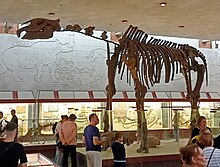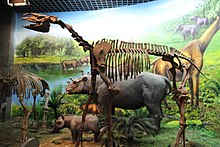113:
404:
155:
132:
459:
112:
499:
by some authors, recent authors treat the paraceratheres as a distinct family, Paraceratheriidae (Wang et al. 2016 recover hyracodonts as more basal than paraceratheres). Some authors choose to include the small, primitive fosterocoopines
423:
were comparable in size with living rhinoceroses with a body mass of three quarters to one and a half tons, while later members grew substantially larger, with the largest representatives (
435:) estimated to have a body mass of 17 to possibly over 20 tonnes, making them the largest land mammals to have ever lived (though possibly equalled or exceeded by some
800:
Martin, C.; Bentaleb, I.; Antoine, P. -O. (2011). "Pakistan mammal tooth stable isotopes show paleoclimatic and paleoenvironmental changes since the early
Oligocene".
665:
905:"A New Species of Forstercooperia (Perissodactyla: Paraceratheriidae) from Northern China with a Systematic Revision of Forstercooperiines"
531:
439:
in body mass). Non-fostercoopine paraceratheriids are united by the possession of a retracted nasal notch, a lack of contact between the
582:
417:
The necks and limbs of paraceratheriids are elongate relative to those of living rhinoceroses. The earliest paraceratheres like
846:"Earliest known unequivocal rhinocerotoid sheds new light on the origin of Giant Rhinos and phylogeny of early rhinocerotoids"
557:
1039:
475:
Their range spanned from
Eastern Europe in the west, the Indian subcontinent in the south, to Northern China in the east.
1034:
466:. It stood about 4.8 metres (15.7 feet) tall at the shoulder and weighed 15 to 20 tonnes (33,000 to 44,000 lb).
1029:
154:
607:
Deng, Tao; Lu, Xiaokang; Wang, Shiqi; Flynn, Lawrence J.; Sun, Danhui; He, Wen; Chen, Shanqin (2021-06-17).
834:
Z. Qiu and B. Wang. 2007. Paracerathere
Fossils of China. Palaeontologia Sinica, New Series C 193(29):1-396
1024:
758:
722:
549:
991:
944:
403:
1001:
986:
857:
809:
759:"Body mass of the giant rhinos (Paraceratheriinae, Mammalia) and its tendency in evolution"
484:
369:
235:
8:
861:
813:
455:
teeth, along with characters relating to the size and shape of the molars and premolars.
880:
845:
782:
698:
641:
608:
535:
345:
149:
924:
885:
786:
774:
703:
685:
646:
628:
563:
553:
916:
875:
865:
817:
766:
737:
693:
677:
636:
620:
539:
527:
431:
303:
770:
821:
543:
502:
425:
409:
323:
263:
216:
122:
967:
624:
496:
206:
32:
1018:
928:
778:
689:
632:
395:. They represent some of the largest terrestrial mammals to have ever lived.
384:
333:
70:
28:
567:
904:
889:
742:
707:
666:"The evolutionary biomechanics of locomotor function in giant land animals"
650:
609:"An Oligocene giant rhino provides insights into Paraceratherium evolution"
452:
293:
978:
436:
45:
681:
506:
444:
440:
273:
131:
90:
55:
870:
392:
166:
95:
39:
938:
961:
920:
903:
Wang, Hai-Bing; Bai, Bin; Meng, Jin; Wang, Yuan-Qing (2018-03-21).
458:
186:
85:
80:
65:
60:
50:
448:
100:
75:
388:
196:
176:
510:) within the family, while they are excluded by other authors.
419:
313:
141:
387:, native to Asia and Eastern Europe that originated in the
583:"A Primitive Rhinoceros from the Late Eocene of Mongolia"
723:"Shoulder height, body mass and shape of proboscideans"
799:
757:
Li, Shijie; Jiangzuo, Qigao; Deng, Tao (2022-07-06).
483:
Paraceratheriids are thought to have been primarily
329:
319:
309:
299:
289:
281:
269:
259:
250:
447:bones of the skull, enlarged upper and lower first
520:
802:Palaeogeography, Palaeoclimatology, Palaeoecology
1016:
902:
843:
606:
534:(1989). "The Systematics of Indricotheres". In
844:Wang, H.; Bai, B.; Meng, J.; Wang, Y. (2016).
756:
495:Although considered a subfamily of the family
383:is an extinct family of long-limbed, hornless
413:individuals compared to a giraffe and a human
793:
714:
548:. New York, New York & Oxford, England:
720:
663:
526:
130:
111:
879:
869:
741:
697:
640:
407:Size comparison one of the largest known
457:
402:
837:
574:
1017:
828:
943:
942:
391:epoch and lived until the end of the
602:
600:
598:
596:
580:
13:
664:Hutchinson, John R. (2021-06-01).
14:
1051:
593:
153:
43:
896:
670:Journal of Experimental Biology
545:The Evolution of Perissodactyls
750:
657:
398:
1:
771:10.1080/08912963.2022.2095908
730:Acta Palaeontologica Polonica
513:
822:10.1016/j.palaeo.2011.07.010
7:
1040:Prehistoric mammal families
490:
462:Artist's reconstruction of
10:
1056:
625:10.1038/s42003-021-02170-6
478:
951:
909:American Museum Novitates
587:American Museum Novitates
351:
344:
247:
242:
150:Scientific classification
148:
138:
129:
119:
110:
23:
16:Extinct family of mammals
1035:Eocene first appearances
470:
721:Larramendi, A. (2016).
550:Oxford University Press
1030:Aquitanian extinctions
743:10.4202/app.00136.2014
613:Communications Biology
467:
414:
987:Paleobiology Database
461:
406:
552:. pp. 358–378.
366:Forstercooperiidae?
862:2016NatSR...639607W
814:2011PPP...311...19M
581:Wood, H.E. (1963).
850:Scientific Reports
763:Historical Biology
682:10.1242/jeb.217463
468:
415:
254:Forstercooperiinae
1025:Paraceratheriidae
1012:
1011:
945:Taxon identifiers
871:10.1038/srep39607
559:978-0-19-506039-3
381:Paraceratheriidae
378:
377:
372:
363:
360:Indricotheriinae
357:
354:Baluchitheriinae
285:Paraceratheriinae
238:
230:Paraceratheriidae
24:Paraceratheriidae
1047:
1005:
1004:
995:
994:
982:
981:
972:
971:
970:
953:Indricotheriinae
940:
939:
933:
932:
900:
894:
893:
883:
873:
841:
835:
832:
826:
825:
797:
791:
790:
754:
748:
747:
745:
727:
718:
712:
711:
701:
661:
655:
654:
644:
604:
591:
590:
578:
572:
571:
542:, R. M. (eds.).
524:
451:and small lower
432:Dzungariotherium
367:
361:
355:
331:
321:
311:
304:Dzungariotherium
301:
291:
283:
271:
261:
252:
233:
228:
158:
157:
134:
115:
105:
42:
27:Temporal range:
21:
20:
1055:
1054:
1050:
1049:
1048:
1046:
1045:
1044:
1015:
1014:
1013:
1008:
1000:
998:
990:
985:
977:
975:
966:
965:
960:
947:
937:
936:
901:
897:
842:
838:
833:
829:
798:
794:
755:
751:
725:
719:
715:
662:
658:
605:
594:
579:
575:
560:
525:
521:
516:
503:Forstercooperia
493:
481:
473:
464:Paraceratherium
426:Paraceratherium
410:Paraceratherium
401:
362:Borissiak, 1923
324:Paraceratherium
264:Forstercooperia
232:
226:
217:Rhinocerotoidea
152:
123:Paraceratherium
106:
104:
103:
98:
93:
88:
83:
78:
73:
68:
63:
58:
53:
48:
37:
36:
25:
17:
12:
11:
5:
1053:
1043:
1042:
1037:
1032:
1027:
1010:
1009:
1007:
1006:
996:
983:
973:
957:
955:
949:
948:
935:
934:
921:10.1206/3897.1
915:(3897): 1–41.
895:
836:
827:
808:(1–2): 19–29.
792:
749:
713:
656:
592:
573:
558:
518:
517:
515:
512:
497:Hyracodontidae
492:
489:
480:
477:
472:
469:
400:
397:
385:rhinocerotoids
376:
375:
374:
373:
364:
358:
349:
348:
342:
341:
340:
339:
338:
337:
327:
317:
307:
297:
279:
278:
277:
267:
245:
244:
240:
239:
224:
220:
219:
214:
210:
209:
207:Perissodactyla
204:
200:
199:
194:
190:
189:
184:
180:
179:
174:
170:
169:
164:
160:
159:
146:
145:
136:
135:
127:
126:
117:
116:
108:
107:
99:
94:
89:
84:
79:
74:
69:
64:
59:
54:
49:
44:
33:Late Oligocene
26:
15:
9:
6:
4:
3:
2:
1052:
1041:
1038:
1036:
1033:
1031:
1028:
1026:
1023:
1022:
1020:
1003:
997:
993:
988:
984:
980:
974:
969:
963:
959:
958:
956:
954:
950:
946:
941:
930:
926:
922:
918:
914:
910:
906:
899:
891:
887:
882:
877:
872:
867:
863:
859:
855:
851:
847:
840:
831:
823:
819:
815:
811:
807:
803:
796:
788:
784:
780:
776:
772:
768:
764:
760:
753:
744:
739:
735:
731:
724:
717:
709:
705:
700:
695:
691:
687:
683:
679:
675:
671:
667:
660:
652:
648:
643:
638:
634:
630:
626:
622:
618:
614:
610:
603:
601:
599:
597:
589:(2146): 1–12.
588:
584:
577:
569:
565:
561:
555:
551:
547:
546:
541:
537:
533:
529:
523:
519:
511:
509:
508:
504:
498:
488:
486:
476:
465:
460:
456:
454:
450:
446:
442:
438:
437:proboscideans
434:
433:
428:
427:
422:
421:
412:
411:
405:
396:
394:
390:
386:
382:
371:
365:
359:
353:
352:
350:
347:
343:
336:
335:
334:Urtinotherium
328:
326:
325:
318:
316:
315:
308:
306:
305:
298:
296:
295:
288:
287:
286:
280:
276:
275:
268:
266:
265:
258:
257:
255:
249:
248:
246:
241:
237:
231:
225:
222:
221:
218:
215:
213:Superfamily:
212:
211:
208:
205:
202:
201:
198:
195:
192:
191:
188:
185:
182:
181:
178:
175:
172:
171:
168:
165:
162:
161:
156:
151:
147:
144:
143:
137:
133:
128:
125:
124:
118:
114:
109:
102:
97:
92:
87:
82:
77:
72:
67:
62:
57:
52:
47:
41:
34:
30:
29:Middle Eocene
22:
19:
952:
912:
908:
898:
856:(1): 39607.
853:
849:
839:
830:
805:
801:
795:
762:
752:
733:
729:
716:
673:
669:
659:
616:
612:
586:
576:
544:
522:
501:
494:
482:
474:
463:
430:
424:
418:
416:
408:
380:
379:
356:Osborn, 1923
332:
322:
312:
302:
294:Aralotherium
292:
284:
272:
262:
253:
229:
140:
139:Skeleton of
121:
120:Skeleton of
18:
532:Sobus, J.C.
528:Lucas, S.G.
399:Description
38:47–23
1019:Categories
619:(1): 639.
514:References
507:Pappaceras
441:premaxilla
274:Pappaceras
243:Subgroups
929:0003-0082
787:250366746
779:0891-2963
690:0022-0949
633:2399-3642
538:, D. R.;
393:Oligocene
368:Kretzoi,
173:Kingdom:
167:Eukaryota
976:BioLib:
968:Q1094909
962:Wikidata
890:28000789
765:: 1–12.
708:34100541
651:34140631
568:19268080
536:Prothero
491:Taxonomy
485:browsers
449:incisors
346:Synonyms
234:Osborn,
223:Family:
197:Mammalia
187:Chordata
183:Phylum:
177:Animalia
163:Domain:
1002:6593405
881:5175171
858:Bibcode
810:Bibcode
699:8214834
642:8211792
479:Ecology
203:Order:
193:Class:
999:uBio:
992:321822
979:416753
927:
888:
878:
785:
777:
706:
696:
688:
676:(11).
649:
639:
631:
566:
556:
540:Schoch
453:canine
389:Eocene
783:S2CID
726:(PDF)
471:Range
445:nasal
420:Juxia
314:Juxia
142:Juxia
925:ISSN
913:3897
886:PMID
775:ISSN
704:PMID
686:ISSN
647:PMID
629:ISSN
564:OCLC
554:ISBN
443:and
370:1940
236:1923
46:PreꞒ
917:doi
876:PMC
866:doi
818:doi
806:311
767:doi
738:doi
694:PMC
678:doi
674:224
637:PMC
621:doi
31:to
1021::
989::
964::
923:.
911:.
907:.
884:.
874:.
864:.
852:.
848:.
816:.
804:.
781:.
773:.
761:.
736:.
734:61
732:.
728:.
702:.
692:.
684:.
672:.
668:.
645:.
635:.
627:.
615:.
611:.
595:^
585:.
562:.
530:;
505:,
487:.
429:,
256:?
96:Pg
40:Ma
35:,
931:.
919::
892:.
868::
860::
854:6
824:.
820::
812::
789:.
769::
746:.
740::
710:.
680::
653:.
623::
617:4
570:.
500:(
330:†
320:†
310:†
300:†
290:†
282:†
270:†
260:†
251:†
227:†
101:N
91:K
86:J
81:T
76:P
71:C
66:D
61:S
56:O
51:Ꞓ
Text is available under the Creative Commons Attribution-ShareAlike License. Additional terms may apply.



